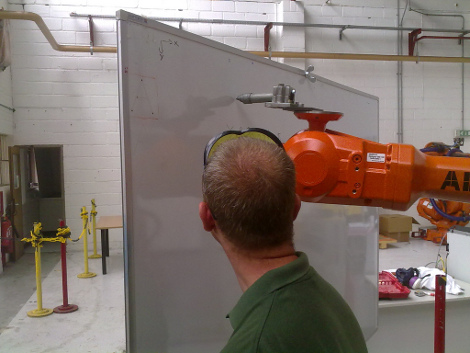
Remember [Mattythorne]? He took a BMW industrial arm and re-purposed it to write twitter messages on a white board. You can read a small excerpt here.
Well [Matt] is back, and as promised includes an entire write up for how he got @scribblebot scribbling twitter messages. It’s a little light on details and we wish there was some more in-depth how-to magic, but then we remembered with most of the population not having an industrial arm in the first place the extra time spent incorporating the extra info would be far from worth it. Regardless, it doesn’t surprise that the previous commentators were not far off the mark in how difficult programing one of these machines would be. While such arms do have a few built in libraries it looks like a very exhausting process to override the default axis of motion, incorporate a UI, build a pen holder, and more. And in the end, is it worth it? [Matt] tells us the arm is going to be going back to monotonous car building work soon, giving weeks of prep only a day in the limelight.
















I’m so mad right now, abusing such a nice robot arm for writing twitter messages.
I hate twitter on it’s own and i love robots but this makes my blood boil.
I worked for a week as an intern at ABB, the company that manufactures and installs these robot arms.
Despite what you may think, these robot arms are extremely easy to program. A custom programming language and environment allows yo to easily and quickly write programs for the arm. Less than 1 hour after being introduced to the robot, I could get it to write my name on a piece of paper.
The language is very high level, allowing you to move the robot arm around each joint, or to move the tip in a straight line in a global x, y and z direction.
Just sharing my experiences!
@chrome
i totally agree. i really want one of these. I was fortunate enough to work in a metal plant where all our machines used these, and I instantly fell in love. Man…..i really hate twitter, but damn it all it has its uses.
http://www.socialtimes.com/2010/08/twitter-rescue-tweet/
I am really beginning to love these mouse-overs.
This one is even cooler … a robot writing the luther bible:
http://www.flickr.com/photos/marcwathieu/sets/72157601299541354/
http://www.robotlab.de/bios/video.htm
I happen to be working with one such robot for industrial applications. However, in the span of developing the Inverse Kinematics library from scratch, I discovered the open source robot programming language – OpenRAVE. It can handle any articulated robot that you can throw at it with ease and has powerful features like constrained motion and trajectory planning. Asking the robot to execute a real-time planned trajectory is pretty easy with this software.
As someone who has done R&D work for ABB I have to say this is a little elementary, very cool but not extremely challenging. Where industrial robot programming gets interesting is when you have to preform a not so repetitive task. IE grinding parts to a close tolerance that are cast but vary +/- 1″ from target anywhere on path, bin picking from random orientations, doing a multi step process where certain steps can be completed in groups but the parts arrive in random time intervals then having to determine how to most efficiently assemble the sub groups and the final part. I am impressed (as always) to see the posters take the topic further and more advanced such as Ashwin mentioning OpenRAVE and kinematic models. Just wanted to give some perspective for those on both camps who say robot programming is easy and those who say its hard you both are correct. For those who say it is easy let me know when you have figured out how to offset a path of 13K point cloud each with a different offset value for griding a part to a 10thou tolerance :).